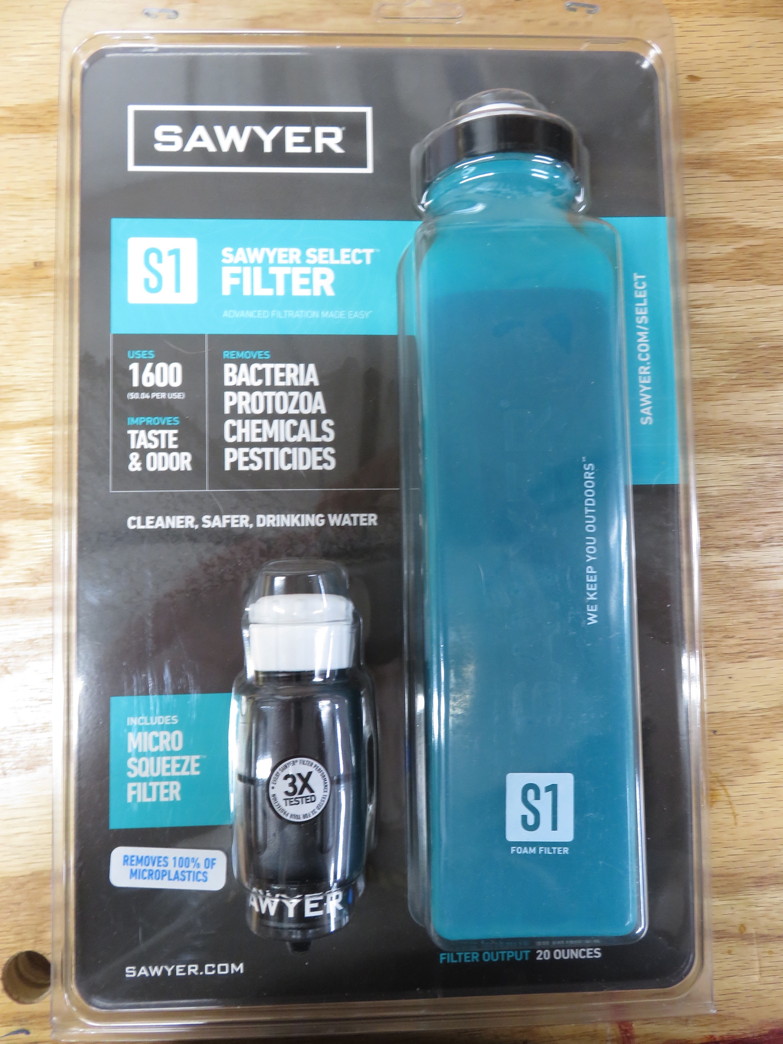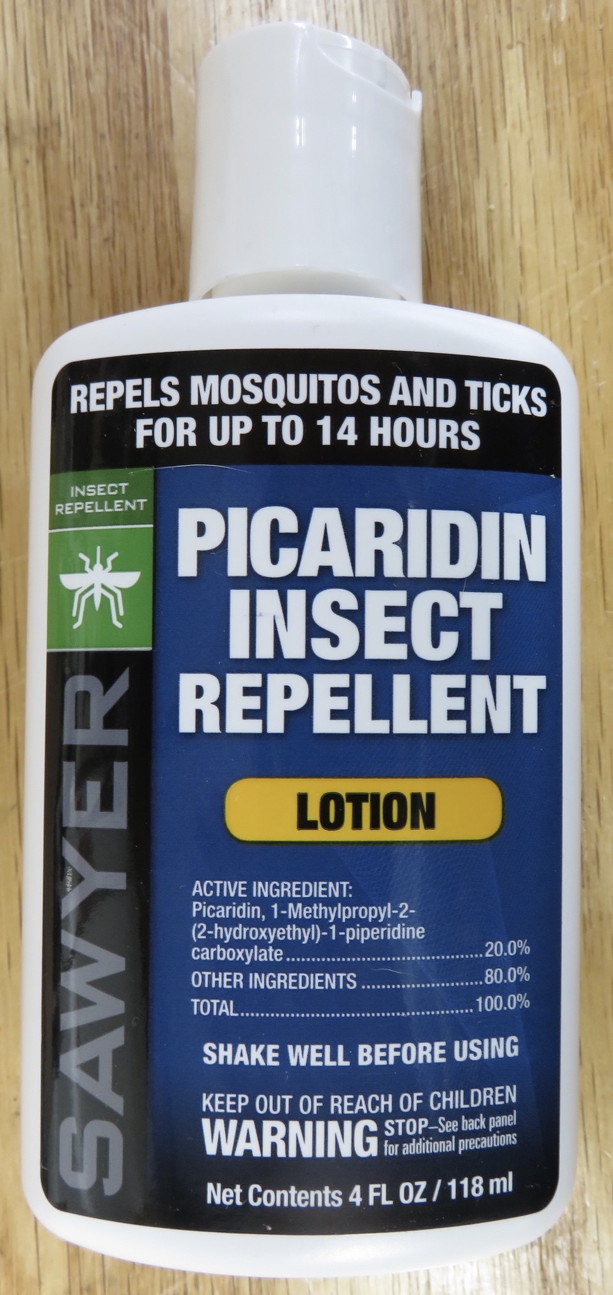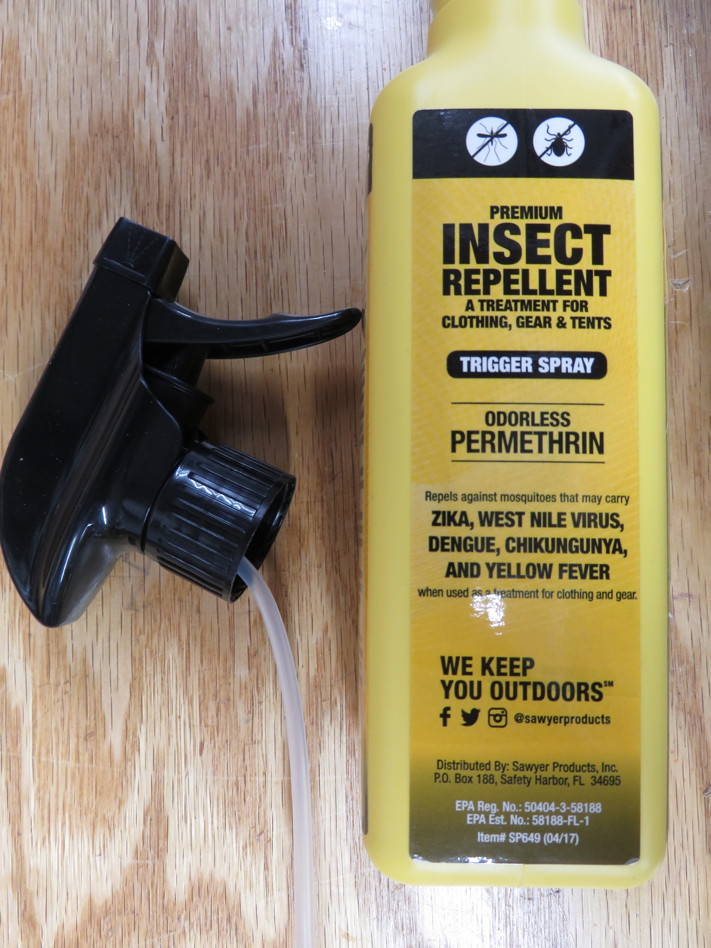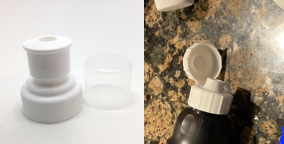

 |
 |
 |
Guest - Not logged in | |||||||||||||||||||||||||||||||||||||||||||||||||||||||||||||||||||||||||||||||||||||||||||||||||||||||||||||||||
Reviews > Water Treatment > Filters > Sawyer S1 Select Water Filter > Test Report by Mike LipaySawyer - S1 Water Filter
by Mike Lipay
Initial Report - October 30, 2021 
The Sawyer S1 Water Filter is an interesting concept in water filtering. Instead of the usual pump action or gravity feed filters this one works by squeezing the soft-sided bottle until the water has been fully filtered, according to Sawyer this takes 20 squeezes. The S1 Water Filter goes beyond filtering for the usual bacteria and viruses, it also filters out chemicals and pesticides, short of spending a couple hundred dollars for a lab test I’m not sure how one would verify the efficacy of the last two items. According to the packaging the Sawyer S1 Water Filter accomplishes this by using a 0.1 micron Hollow Fiber Membrane combined with a proprietary Foam membrane. In additional a carbon filter is used for both additional filtering and taste. Filtering can take as little as 10 seconds, and reduces the contaminants below current EPA standards.
Initial Impressions
The Sawyer S1 Water Filter is good for an estimated 1,600 uses, or between 250 and 273 gal (946-1,035 L). Personally, that is way beyond my abilities to actually track so I will probably figure on replacing it every 5-6 years, which seems a reasonable amount of time for the cost. 
The bottle itself is soft sided, required to accomplish the squeezing needed to filter the water (an interesting procedure which I will get into). When fully assembled I find it a bit tall for comfortable usage and carrying (see image to the left, Sawyer S1 next to my usual water bottle); the bottle holder in my pack, and the leather hip holder I use were not built with a bottle this tall in mind, I will be curious to see how they handle it. The material itself feels odd (rubbery), and does seem to pick up dust and other small particles lying around, I will be curious to see how this does in the outdoors. The Sawyer S1 Water Filter has to be primed before its first use. This is to flush the system of small bits of absorption material that may have entered the bottle during manufacture, or come loose during shipping. While not harmful the material may leave a metallic taste in the water, and may prematurely clog the filter, requiring back flushing sooner than what is normal. The procedure to prime the system is to fill the bottle halfway, attach the filter to the bottle, squeezing the bottom then top of the bottle to force the water through the filter (repeat 10 times); next remove the filter, fill the bottle to the fill line (hard to see), replace the filter and squeeze the bottle again for another 10 times; finally remove the filter, invert the bottle and roll the bottle up from its bottom to squeeze as much of the water out of the bottle as possible. The bottle is now ready for use. About the priming, it sounds easier than it was. The instructions that come with the bottle say that it will hold 20-22 oz (591-651 ml) so I measured out half of that in a measuring cup and began pouring it into the bottle, two things quickly became apparent: you can’t see the amount of water in the bottle because of the filter medium; it took in very little before it began overflowing, seems the medium inside the bottle takes a while to absorb the water. I found that if I slightly squeezed the bottle at the top then slowly released the bottle while pouring in the water that I could get a lot more into the bottle before it “filled up”. After filling halfway (by measure still couldn’t see a water level) I put the filter on the bottle and began squeezing, after 10 times I filled the bottle (again, by measure) and repeated the squeezing. After I finished the priming I removed the filter and squeezed out as much water as I could. I then weighed the bottle out of curiosity, empty but primed the bottle (with filter) weighs 15 oz (416 g), pretty hefty for an empty bottle. I already have a few concerns about the bottle, first (as stated above) is the height, primarily if either of my bottle holders (pack or hip) will hold the bottle while hiking. The second is in filling the bottle, the photos on Sawyer’s website show the bottle being partially immersed in the water to fill it, based on the priming I’m not sure that immersion alone will be enough to fill the bottle. The instructions for use say to remove the filter, immerse the bottle and fill to the fill line, replace the filter and do the squeeze procedure (squeeze lower half, upper half, repeat 10 times), the replace the filter and either drink from the bottle or squeeze it into another container. Doing it this last way is similar to using a gravity filter in that it is necessary to carry two bottles in order to filter the water, only this setup is heavier than a gravity setup. Cleaning Because of its unique makeup cleaning the Sawyer S1 Water Filter is a bit different than most filtration systems, not difficult, just unique. First, the bottle itself, with the integrated foam filter, is the part with the limited lifetime as the foam filter cannot be 100% cleaned, as with a pump filter debris will accumulate in the foam clogging the foam at some time, how soon will depend on the cleanness of the water. No instructions are given for cleaning the bottle itself. Second is the cleaning of the filter, and for the two methods are provided, which one used is purely the decision of the owner, both methods are outlined here:
Free Gifts I don’t know how long it will continue, but the Sawyer S1 Water Filter arrived with two free gifts: 

A bottle of Sawyer Picaridin Insect Repellent for use on the skin. The bottle claims to repel mosquitoes and ticks for up to 14 hours if used as directed. And a bottle of Sawyer Permethrin Insect Repellent that is to be applied to clothing. This promises to repel ticks and mosquitoes for up to 6 washes when applied as directed. I have used this in the past and find that it does do a decent job. Top Field Report - Dec 29, 2021 First Use Never go into the field with new equipment without first using it at home. I’ve lived by this mantra my entire hiking life, and the Sawyer S1 Water Filter is one example of why. At first I thought using it would be just like any other bottle: tip it up and sip, ‘taint so. Doing it this way I found it very hard to draw water just by drinking, I got a little bit that way, the amount that wasn’t inside the foam, once I drank it there was no more easy water to drink, I had to get the water out of the foam by squeezing it to release water from the foam. I am beginning to think that this is not the way to go with the S1, the other option is to fill it up then force squeeze the water into another bottle for drinking. I will continue to test it both ways over the coming months to see if things change as it ages, and as I get used to it. Regarding the filtering, I filled the bottle up with bottled water that contains calcium, salt, and other minerals meant to “improve the taste”. Personally, water, like vodka, shouldn’t have much of a taste, which is why I tend to avoid bottled waters that contain additives (and flavored vodkas). The Sawyer S1 water filter did a good job of removing these additives and restoring the “real taste” of water. I am both impressed and pleased with the filtration ability. 
After reading the instructions, and looking at the product on their website, I noticed that the cap I have is different from what is described and shown, I don’t know how this may affect my experience with the product versus having the cap that was described, this should be noted and kept in mind. The cap that the instructions talk about is a push/pull cap, where what I have is a flip-top cap, this could affect some aspects such as drawing water while drinking.
Additional Notes: As I said above, the cap on the S1 popped off when I was trying to fill up my water bottle. When I got back home I contacted Sawyer about the issue, their response was to: flush bottle itself with clean water (note: tap water cannot be used because of the chemicals, so I had to use purified bottle water), then back flush the squeeze filter. After this securely fasten the cap and check prior to each use that the cap is firmly attached, then let them know if the issue occurred again. Problem is, I have never removed the cap, so it became loose on its own. I'm a bit wary about using the S1 on future backpacking trips, so I plan on carrying an alternate filtering system in case this should happen again. Long Term Report - Feb 22, 2022
Update I received the instructions below in an email from the Sawyer rep and followed the instructions. The first two back-flushes had some pretty dark looking water coming out of the filter, after six times the water was finally clear. I then filled the bottle itself with the distilled water, squeezed it to "filter" the water, then emptied it into the sink - the water was as black as what had come out of the filter. It didn't improve the second time I did it, no wonder the filter had clogged up after only a few uses. As in the instructions I continued to flush the filter after every trip. Honestly, that became expensive, requiring me to purchase a bottle of distilled or purified water after every trip, an inconvenience when I traveled to New England, and again to Arizona. I never had the clogging issue again, although, with each use the filtering process became harder, indicating the necessity to flush it when I either got back home or to the hotel/hostel I was staying before the trip back home. There is one problem with the backflushing process - the syringe they provide has threads on the tip, but there are no matching threads on the filter, so it is necessary to hold the syringe tightly against the opening in the filter. Forcefully pushing the water through the filter forces some of the water out between the contact point for the syringe and the filter, spraying water all over the place (note that this is blackened water like in the photo). If this is supposed to be a regular (after every trip) process then the filter should have matching threads to prevent/lessen the spray. Instructions from Sawyer:We recommend backwashing your filter after each outing, or when your flow rate begins to diminish, before prolonged storage, and when you're ready to start using your filter again. Backwashing your filter after storage is a great way to re-wet the filters and restore the flow rate before use. Soak the filter in hot water (not to exceed 135 F) for ~30 min to loosen up any residual particulate built up in the filter fibers and then backflush several times with hot water as hard as possible. If the flow is still slow, repeat the process for a blocked filter below. For general maintenance of your filtration system, we'd recommend backwashing and then sanitizing the unit before storing your filter. To sanitize the filter, we'd recommend using a weak bleach solution (one capful of bleach per Liter of water). Slosh the weak bleach solution around in your pouch and run it through the filter. After the pouch and filter have been sanitized, let the filter sit upright with sufficient ventilation to dry out before storing the filter in a cool/dry location away from direct sun exposure. Top Summary What I like about the Sawyer S1 Water Filter:
What I don't like about the Sawyer S1 Water Filter:
Acknowledgement This ends my Long Term Report, I’d like to thank Sawyer and BackpackGearTest.org for the opportunity to test the S1 Water Filter. Read more reviews of Sawyer Products gear Read more gear reviews by Mike Lipay Reviews > Water Treatment > Filters > Sawyer S1 Select Water Filter > Test Report by Mike Lipay | ||||||||||||||||||||||||||||||||||||||||||||||||||||||||||||||||||||||||||||||||||||||||||||||||||||||||||||||||||